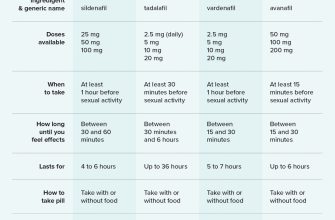Celebrex is primarily used to manage pain and inflammation resulting from conditions like arthritis, acute pain, and menstrual discomfort. For adults, the typical starting dosage for osteoarthritis or rheumatoid arthritis is 200 mg per day, which can be divided into two doses of 100 mg each, or taken all at once. For patients requiring treatment for acute pain, a dosage of 400 mg can be administered as a single dose, followed by 200 mg if needed on the first day.
It’s important to tailor the dosage to individual needs, taking care not to exceed 400 mg per day unless directed by a healthcare provider. Consider monitoring for side effects such as gastrointestinal discomfort or cardiovascular issues, which may arise during treatment. Always consult a physician before altering dosage or frequency to ensure safe use.
For the elderly or those with liver or kidney concerns, starting at a lower dosage of 100 mg daily may be advisable. Ensure regular follow-ups with healthcare professionals to assess the effectiveness and safety of the treatment.
- Celebrex Usage and Dosage
- Recommended Dosage Guidelines
- Administering Celebrex
- Understanding Celebrex and Its Indications
- Recommended Dosage for Adults
- Specific Conditions
- Administration Guidelines
- Dosage Adjustments for Special Populations
- Administration Guidelines for Optimal Effectiveness
- Potential Side Effects and Management
- Important Drug Interactions to Consider
- 1. Anticoagulants
- 2. Antidepressants
- 3. Diuretics
- 4. ACE Inhibitors
- 5. Lithium
- Monitoring and Follow-Up During Treatment
- Assessing Response to Treatment
- Monitoring Side Effects
- Frequently Asked Questions About Celebrex Usage
Celebrex Usage and Dosage
Celebrex is indicated for relieving pain and inflammation caused by various conditions, including arthritis and menstrual pain. Dosage must be tailored to individual needs, considering the specific condition and patient response.
Recommended Dosage Guidelines
For most adults, the typical starting dose is 200 mg taken once daily or 100 mg taken twice daily. Depending on the patient’s response, the dose may be adjusted. Maximum daily dosage should not exceed 400 mg.
Administering Celebrex
Take Celebrex orally with or without food. Consistency in timing helps maintain stable levels of the medication in the body. Always follow the healthcare provider’s instructions for optimal results. If a dose is missed, take it as soon as remembered unless it’s close to the time for the next dose. Avoid doubling up on doses.
| Condition | Starting Dose | Maximum Dose |
|---|---|---|
| Osteoarthritis | 200 mg once daily | 400 mg daily |
| Rheumatoid Arthritis | 100 mg twice daily | 400 mg daily |
| Acute Pain | 400 mg on the first day, followed by 200 mg as needed | 400 mg daily |
| Dysmenorrhea | 400 mg initially, then 200 mg as needed | 400 mg daily |
Monitor for side effects, particularly gastrointestinal issues and cardiovascular events, which can occur with prolonged use. Regular check-ins with your healthcare provider are recommended to evaluate the treatment’s effectiveness and adjust the dosage as necessary.
Understanding Celebrex and Its Indications
Celebrex, containing the active ingredient celecoxib, serves as a non-steroidal anti-inflammatory drug (NSAID). It effectively alleviates pain and inflammation associated with various conditions. It’s recommended for adults experiencing osteoarthritis, rheumatoid arthritis, ankylosing spondylitis, and acute pain. Doctors may also prescribe it for menstrual pain and certain conditions involving inflammation.
For osteoarthritis and rheumatoid arthritis, Celebrex helps reduce joint pain and improve mobility. It targets the COX-2 enzyme, which plays a significant role in the inflammatory process. This selective inhibition leads to fewer gastrointestinal side effects compared to traditional NSAIDs, making it a preferred choice for individuals who require long-term treatment.
In cases of acute pain, such as post-operative pain or injury, Celebrex can provide significant relief. The standard dosage typically starts at 200 mg per day, divided into one or two doses, but individual needs may vary. Consultation with a healthcare provider is crucial to determine the appropriate dosage based on specific health conditions and treatment responses.
Patients with a history of cardiovascular disease, hypertension, or gastrointestinal issues should approach Celebrex with caution. Regular monitoring and communication with a healthcare professional ensure safe usage. Always discuss potential risks and benefits before starting treatment.
In summary, Celebrex effectively manages various types of pain and inflammation. Following a doctor’s advice regarding dosage and monitoring can enhance treatment outcomes for those in need.
Recommended Dosage for Adults
The typical starting dose of Celebrex (celecoxib) for adults is 200 mg per day, which can be taken as a single dose or divided into two 100 mg doses. For those who need additional relief, the dosage can be increased to 400 mg per day based on response and tolerance.
Specific Conditions
For osteoarthritis and rheumatoid arthritis, the recommended dosage is 200 mg per day, which may be adjusted to 100 mg twice daily if necessary. In acute pain management, a higher initial dose of 400 mg may be used, followed by 200 mg on the first day as needed.
Administration Guidelines
Take Celebrex with food to enhance absorption and minimize gastrointestinal irritation. Consistency in taking the medication at the same time each day helps maintain stable drug levels in the body. Adjustments to dosage should only be made under the supervision of a healthcare professional.
Consult your doctor before making any changes to your dosage or if you experience any adverse effects while taking Celebrex.
Dosage Adjustments for Special Populations
In patients with hepatic impairment, a dose reduction of Celebrex is recommended. For mild impairment, the usual dosage may be safely maintained. However, for moderate to severe hepatic impairment, consider reducing the maximum daily dose to 200 mg. Monitor for signs of toxicity closely.
For individuals with renal impairment, dosage adjustments depend on the severity of the condition. In those with mild renal impairment, no dosage adjustment is necessary. In moderate impairment, initiate treatment with 100 mg daily and adjust as needed. In cases of severe renal impairment, limit the daily dose to 200 mg, while closely monitoring renal function.
Patients aged 65 and older may require lower doses due to increased sensitivity to NSAIDs and potential for increased side effects. Start with the lowest effective dose, typically 100 mg once daily, and titrate based on response and tolerability.
Pregnant patients, particularly in the third trimester, should avoid Celebrex due to risks of adverse effects on the fetus. Always discuss alternative pain management strategies with healthcare providers during pregnancy.
In children under 18 years, Celebrex use is not recommended unless specifically indicated and prescribed due to safety and efficacy not being established in this population. Consult with a healthcare professional for appropriate alternatives.
Careful assessment and monitoring in these populations will ensure safe and effective use of Celebrex, minimizing risks while addressing the need for pain management.
Administration Guidelines for Optimal Effectiveness
Take Celebrex with food to reduce the risk of stomach upset. Consuming it alongside a meal enhances absorption and minimizes gastrointestinal discomfort.
Follow the prescribed dosage carefully. Typical dosages range from 100 mg to 200 mg daily, depending on your condition. Do not exceed the maximum recommended dose without consulting your healthcare provider.
Swallow the capsule whole with a full glass of water, avoiding crushing or chewing. This ensures the medication reaches your system effectively without compromising its action.
Maintain a consistent dosing schedule. Taking Celebrex at the same time each day helps maintain stable levels in your bloodstream, promoting better relief from symptoms.
Stay hydrated while on Celebrex, as adequate fluid intake can mitigate potential side effects. Drinking enough water supports kidney function and reduces the likelihood of complications.
Monitor your response to the medication. If you notice any adverse reactions, such as swelling, abdominal pain, or unusual bruising, contact your healthcare provider promptly.
Avoid using Celebrex in combination with other NSAIDs unless directed by your doctor. This practice minimizes the risk of gastrointestinal and cardiovascular side effects.
Regular check-ups with your healthcare provider are advisable to assess your response to treatment and to make any necessary adjustments to your dosage or medication plan.
Potential Side Effects and Management
Celebrex may cause gastrointestinal issues, including nausea, diarrhea, and abdominal pain. Maintain hydration and consider consuming smaller, more frequent meals to alleviate these symptoms. If nausea persists, consult your healthcare provider about possible modifications in dosage or alternative medications.
Cardiovascular risks are associated with Celebrex, including potential heart attack or stroke. Monitor your heart health regularly, especially if you have pre-existing conditions. Engage in discussions with your doctor about cardiovascular risks and how to manage them effectively.
Renal function may be affected, particularly in individuals with existing kidney issues. Regularly check kidney function through lab tests as advised by your healthcare professional. Adequate hydration supports kidney health; aim for sufficient fluid intake unless contraindicated.
Allergic reactions, though rare, warrant immediate attention. Symptoms include rash, itching, or swelling. In such cases, discontinue use and seek medical assistance right away to address the reactions appropriately.
Skin reactions may also occur, such as rashes or sensitivity to sunlight. Use sunscreen and protective clothing to minimize sun exposure. Inform your healthcare provider about any skin changes experienced during treatment.
If you notice any severe side effects, such as chest pain, shortness of breath, or unusual swelling, seek emergency medical help. Regularly communicate with your healthcare team about your experience on Celebrex to ensure ongoing safety and efficacy.
Important Drug Interactions to Consider
Pay close attention to the following drug interactions when using Celebrex:
1. Anticoagulants
- Increased risk of bleeding when combined with warfarin or other anticoagulants.
- Regular monitoring of INR levels is advisable.
2. Antidepressants
- The combination of Celebrex with SSRIs or SNRIs may elevate bleeding risk.
- Consult your healthcare provider about alternatives or additional monitoring.
3. Diuretics
- Non-steroidal anti-inflammatory drugs (NSAIDs) like Celebrex can reduce the effectiveness of certain diuretics.
- Monitor kidney function if taken together, especially in patients with renal impairment.
4. ACE Inhibitors
- Combining Celebrex with medications like lisinopril may decrease their blood pressure-lowering effects.
- Keep an eye on blood pressure readings during treatment.
5. Lithium
- Celebrex may increase lithium levels in the blood, enhancing toxicity risks.
- Regular lithium level checks are recommended.
Always discuss your complete medication list with your prescribing doctor to ensure safe and effective use of Celebrex while managing interactions appropriately.
Monitoring and Follow-Up During Treatment
Regular monitoring is key to ensuring the safe and effective use of Celebrex. Schedule follow-up visits with your healthcare provider every three to six months. These appointments allow for assessment of how well the medication is working and any potential side effects.
Assessing Response to Treatment
During each visit, discuss your pain levels, mobility, and overall well-being. This feedback helps your provider determine if any adjustments in dosage are necessary. Keep a pain diary to track changes in symptoms and response to Celebrex, which can provide valuable insights during consultations.
Monitoring Side Effects
Be alert for any side effects such as gastrointestinal discomfort, cardiovascular symptoms, or unusual bruising. Report these promptly to your doctor. Performing blood tests may be recommended periodically to check kidney and liver function as well as to monitor blood cell counts. Following these guidelines ensures a proactive approach to treatment continuity and safety.
Frequently Asked Questions About Celebrex Usage
Take Celebrex with food or milk to reduce the risk of stomach upset. This helps to enhance absorption and minimize gastrointestinal side effects.
The typical dosage for adults is 200 mg once daily or 100 mg twice daily. Your healthcare professional may adjust this based on your specific condition and response to treatment.
When using Celebrex, monitor for side effects. Common reactions include headache, dizziness, and gastrointestinal issues. Report any unusual or severe symptoms, such as chest pain or swelling, to your doctor immediately.
- Can I take Celebrex with other medications? Always inform your doctor about any other prescriptions or over-the-counter drugs you are using. Some medications can interact with Celebrex, affecting its effectiveness.
- Is Celebrex safe for long-term use? Long-term use can increase the risk of cardiovascular issues and gastrointestinal complications. Regular check-ups with your doctor are essential to manage risks.
- What should I do if I miss a dose? Take the missed dose as soon as you remember. If it’s almost time for your next dose, skip the missed one. Never double up to make up for a missed dose.
- Is Celebrex suitable for everyone? Not everyone should take Celebrex. Discuss your medical history with your doctor, especially if you have a history of heart disease, high blood pressure, or liver problems.
Pregnant or breastfeeding individuals should consult with a healthcare provider before taking Celebrex, as it may not be suitable during certain stages of pregnancy.
Pediatric use of Celebrex is generally not recommended. Consult a pediatric specialist for appropriate pain or inflammation management in children.










